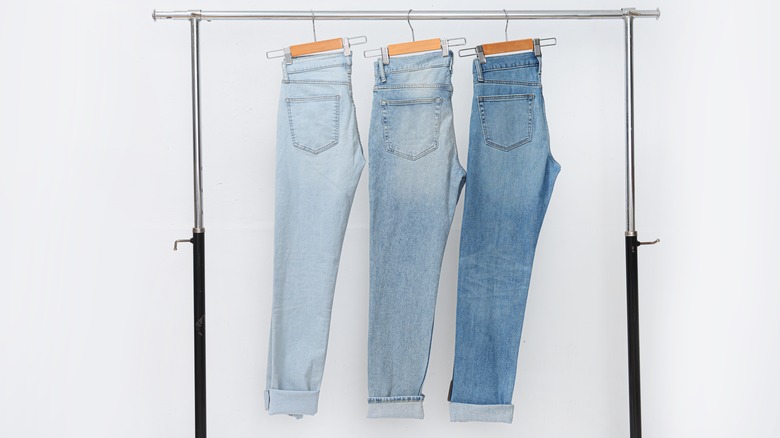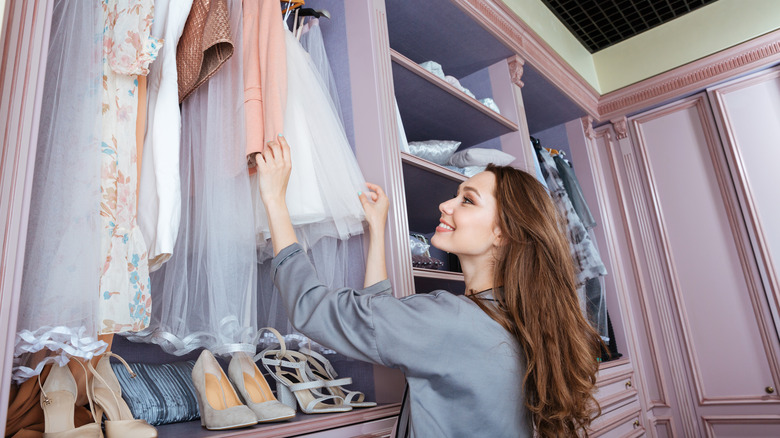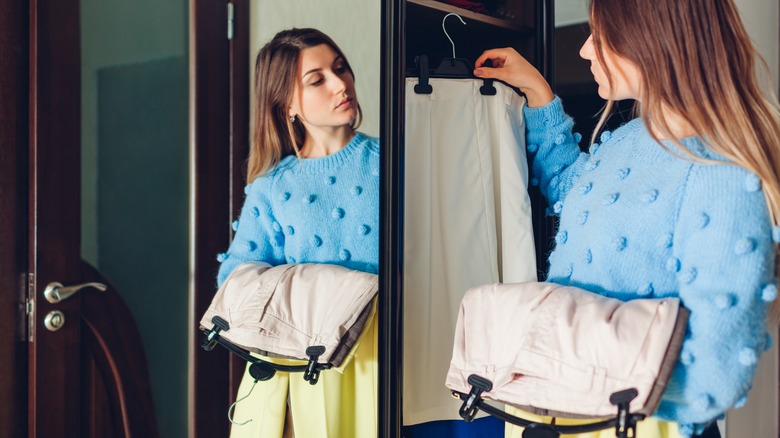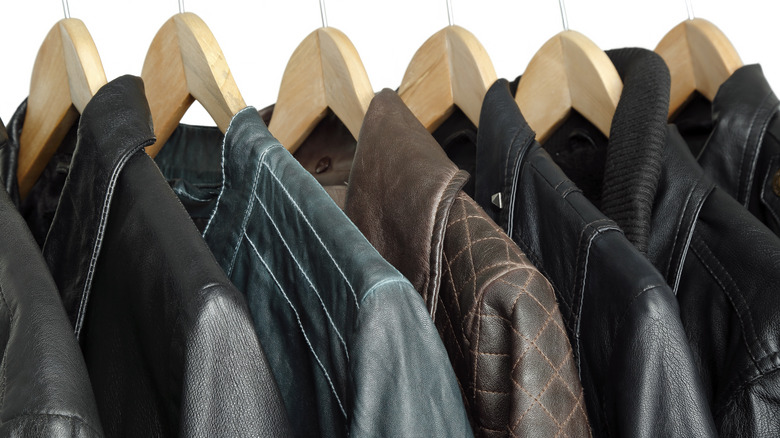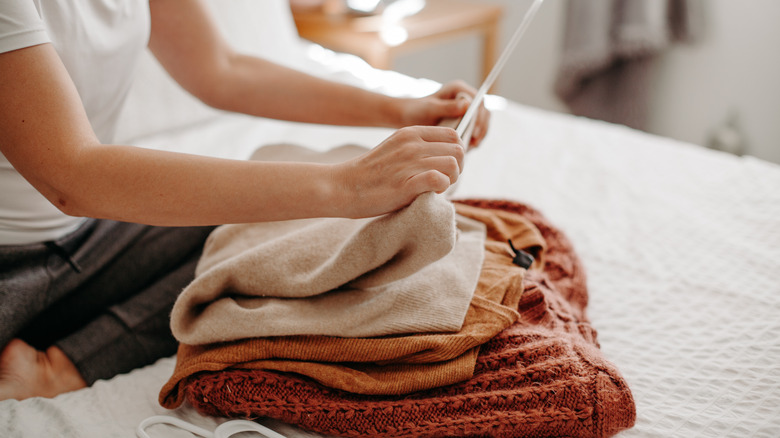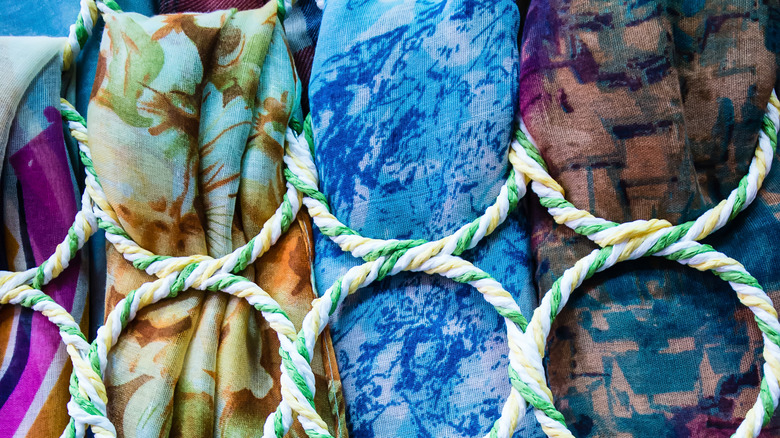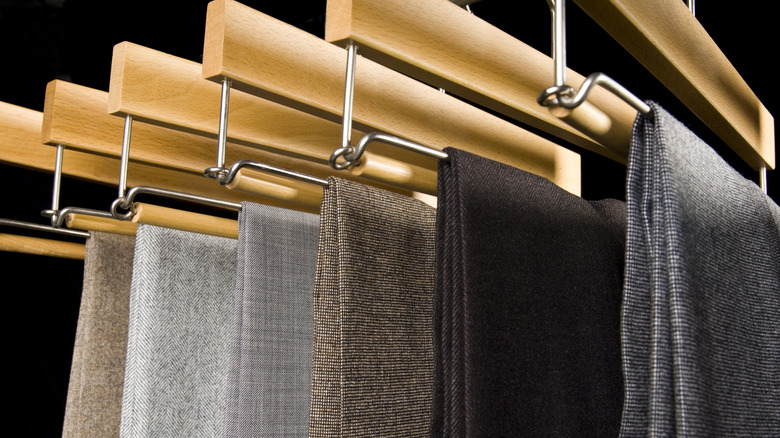The Best Way To Hang Every Type Of Clothing
When you try to organize your wardrobe, it's common to focus on getting everything in as simply and efficiently as possible. However, not every method works well, and recognizing this can help prevent you getting frustrated and shoving your stuff in and shutting the door. Each type of clothing you have benefits from a specific hanging method to keep the fabric wrinkle-free and strong.
Instead of trying to force everything into your closet, you want to focus on how to hang your different garments, from delicate silk items or formalwear to heavy winter sweaters or coats. You should also understand why traditional hanging methods may be damaging your clothes or making them take up a huge amount of room. For example, A lot of people twist knitwear on thin hangers before popping them in the closet, and this can cause the fibers to stretch and deform. Also, if you haven't already, consider making the switch to padded or wider hangers for your dresses and suits.
By focusing on these things, we'll help you keep your clothes looking nice and fitting great. They will be ready to go whenever you want to wear them. Whether you want to streamline your clothing care to maximize your closet space or you're a fashion enthusiast with a lot of valuable pieces, simple techniques make a huge difference in how your wardrobe fits and lasts.
Use wooden hangers for button-up shirts to maintain the shape
To hang and store your button-up shirts, put them on wooden hangers. Never use wire clothing hangers. Button the top, third, and fifth buttons on your shirt to stop it from gaping and ensure it hangs smoothly. Lay your shirt face down on a flat surface and align the seams to prevent the fabric from twisting. Lift your shirt by the tail, gently fold each sleeve toward the center, and line up the cuffs with the tail to stop the fabric from stretching or creasing. Put the shirt on your wooden hanger, ensuring the shoulders fit over the curved ends.
Wooden hangers help keep the shirt's shape and quality. These hangers offer sturdy support without stressing the fabric's fibers, unlike wire hangers that can leave marks or distort the shape. The hanger's contoured, broad shoulders mimic your shoulders, and this helps keep the shirt's shoulder structure so it's wrinkle-free. The smooth surface prevents the shirt from snagging, and buttoning the few buttons lets you keep the shirt in the right place on the hanger when you store it. It also boosts airflow around the shirt to keep the fabric fresh.
Fold jeans vertically and clip by the waistband
To hang your jeans, fold them vertically. Lay them flat, carefully smooth any wrinkles, and fold them in half, working from left to right until you match the front and back seams. Ensure the outer seams and inseams align. Use clip hangers designed to hold skirts and pants. Attach the clips to the waistband, keeping the jeans as balanced as possible so they hang straight down.
Hanging your jeans by the waistband after you fold them vertically will help keep their shape and prevent the creases you typically get from folding them conventionally. This saves space, allowing you to put several pairs of jeans in the same area, making it a great idea to organize a small closet. The clips give the grip to hold your jeans in place without slipping off, and hanging them by the heaviest part ensures you evenly distribute the fabric's weight, preventing distortion in the seat or knee areas. You'll be able to see all of your pairs of jeans at once, and they will be ready to wear without needing to steam or iron.
Fold dresses over the hanger's horizontal bar or use two sturdy tissue-lined hangers
There are two ways to easily hang long dresses easily for storage purposes, especially your dresses with heavy skirts or delicate fabrics. If you can fold your dresses without damaging the fabric or shape, get a padded hanger with a horizontal bar. Fold your dress in half horizontally, and drape it over the bar so the waistline aligns with the center of the hanger, ensuring the fabric doesn't pinch. The weight hangs evenly to stop the fibers from stretching. Folding helps stop the shoulders or neckline from distorting as they commonly do with traditional hanging methods.
If your dress needs more support, get two tissue-lined, sturdy hangers. Put a piece of acid-free tissue paper on each hanger so there's a buffer to prevent snags. Hang the bodice (top part of the dress) on the first hanger, and attach your second hanger at the waistline or to the skirt to distribute the weight across two points. Using two tissue-lined hangers is excellent for delicate fabrics, like chiffon or silk, because it divides the garment's weight between the skirt and top, keeping the shape. It also works well for heavy or elaborate dresses that can get damaged or misshapen under their own weight without more support.
Use clip hangers and hang skirts by the waistband
To hang your skirts using clip hangers, you'll want adjustable clips that can slide along the hanger's bar to fit different skirt sizes to ensure that they stay balanced. Open the clips and put the skirt in them by lining up the waistband with the top edge of the hanger. Ensure you clip at the waistband because this is the most vital part of the garment to support the weight as it hangs. The clips should be equal distances from the waistband's center so it doesn't sag to one side. If your skirts are delicate, pad the clips with acid-free foam to stop them from making indentations. Position your hanger so your skirt drapes vertically, smooth out any wrinkles or folds, and hang it.
Using the waistband to hang skirts preserves your garment's shape. The waistband comes designed to bear weight, so clipping them here stops the fabric from losing shape or stretching. It also minimizes wrinkles because you're hanging your skirt fully extended. Gravity will slowly pull minor creases out, and this means you don't have to iron it before you wear it, and it's better for the fabric's longevity. Adjustable clips ensure you can securely and neatly hang skirts of varying sizes without slipping. It maximizes your closet space and makes it easier to pull out the skirt you want.
Hang blazers, jackets, or leather coats on broad cedar suit hangers
When you hang your blazers, jackets, or leather coats, use cedar broad suit hangers that match your garment's weight and size. Butler Luxury recommends a width of 1.5 to 2 inches. Hold the garment by the collar and carefully drape it over your hanger. The hanger's broad shape will fill out your garment's shoulders to stop them from sagging or losing their form. Always make sure to empty the pockets before you hang your jacket and to leave it unbuttoned to retain the shape.
This style hanger ensures you get something that supports heavier garments without bending. These hangers also match the garments' shoulder shape, reducing the strain on the fabric and keeping the shoulder construction intact. Additionally, the cedar smell wards off both pantry and closet moths, which is great for saving your jackets. The cedar also leaves a nice smell to keep the closet fresh.
Fold the body of a sweater over the hanger
Did you know there is a risk-free way to hang sweaters to avoid damaging them? You'll need a flat, wide hanger covered with fabric or padded. Fold the sweater in half vertically, lining the arms up on each side. Hold your sweater by the armpits, put the fold over the hanger bar so the hanger is in the armpit area, and fold the sweater so it drapes evenly from both sides. Smooth your sweater's arms along the body to keep them from stretching or dangling, and fold them gently back over the sweater's body to help prevent stretching. The shirt's bottom half should hang at the back of the hanger to help distribute the garment's weight and stop stretching out the neckline and shoulders.
Folding the sweater over your hanger will help hold its shape and protect the fabric. It minimizes the stress on the seams, shoulder, and neck and stops the impression marks your hangers can leave on the shoulders. You'll keep the sweater's natural drape, reducing wrinkles and ensuring it's ready to go. It works well for bulky or heavy sweaters, which are more prone to losing shape during storage.
Loop scarves through a scarf ring
To hang your scarves, a scarf ring helps keep them neat and organized. You can even make a scarf ring from an old shower curtain ring. To hang your scarf on a ring, hold it in the middle to get an even fold. Slide the folded end through the ring until you have enough fabric to make a small loop. Pull the loose ends of the scarf through the loop, gently tugging on the ends to secure the ring so it hangs without any wrinkles or twists. Ensure you hang your scarf ring on a sturdy hook or hanger, especially if you want to put several scarves on one ring.
Using a scarf ring to hang your scarves helps you maximize your space. When you have many of these accessories, they can take up a large amount of drawer or shelf space. Hanging them lets you consolidate them in one spot and uses vertical space, which many people skip. It also keeps your scarves from tangling and wrinkling, which is common when you fold them in drawers. Hanging lets each scarf dangle downward, minimizing creases and keeping them in ready-to-wear shape. It stops them from getting damaged or stretched so they can last longer by gently looping them through the ring instead of pulling at them.
Hang swimwear on a padded hanger to maintain shape
To hang your swimwear in the off-season while keeping its shape, use a padded hanger. Swimwear can be made from delicate fabric like crocheted knits. Ensure you wash your swimwear the right way, and dry it before you store it to prevent odors and mold growth. Take the top part of your swimwear and fold it in half over your padded hanger. The straps should be evenly spaced, and the cups should have support. Bikini bottoms can get draped over the hanger's lower bar. This keeps both pieces paired. Finish by smoothing out any wrinkles to help the fabric keep its shape. Use clips from pants hangers and clip the waistband of swim trunks or shorts before putting them in your closet.
You can also store swimsuits folded in plastic boxes, but hanging allows you to see all of your swimwear at a glance. Hanging also allows air to circulate around your garment, preventing moldy or mildew smells.
Hang dress pants using the Savile Row Fold
Hold the pants upside down from the legs to hang your dress pants using the Savile Row Fold. Line up the seams of both legs to ensure the pants' legs are straight. Fold one leg over the hanger's bar and tuck the hem just behind the crotch. Allow the bottom of the pants to drape over the bar, and fold the second leg over the first, ensuring it hangs smoothly and the position and length line up with the first leg. This fold gives you a gentle curve that mimics how your pants drape when you wear them, helping to stop wrinkles and keep the crease. Adjust the placement on the hanger so the waistband is nicely balanced, and your pants hang straight. You want the crotch to hook over the hanger's bar to secure the pants so they don't slide.
The Savile Row Fold keeps your pants' natural crease, helping preserve the sharp look and detailed tailoring, like pleats and cuffs, especially for business and formalwear. It stops wrinkles or creases from forming in spots you don't want, reducing your need to iron them out.



